A visit to the monastery and much wisdom to be grateful for is found. An offering.
by mdvfunes
I have been desperate to try week 2 assignment to break down a commercial in 5 seconds increments – I did not even look at the list we were provided as I had a commercial in mind.
I used Vialogues to break it down and make notes. As Christina Hendricks says in her post about this activity, it is not only fun but really revealing. if you want to join me in Vialogues and make your own notes on the commercial you are welcome. I made it public so anyone can comment.
I have seen this advert/commercial many times and it is an all time favourite. I never stopped to ask why or what was the shape of the story. In week one I explored the story spine technique through a video I made. A series of unconnected images that seemed to come alive in a story just by the addition of the story spine structure. This was fascinating to me. How humans add stuff that is not there, just to make a story even when there isn’t one.
Here is the story spine for my advert:
Once upon a time there was a cat that saw life as ‘meh!’
Every day passed with cat just lying there whilst the world passed him by
But one day whilst lying bored on the sofa he had a thought that changed his life. Why be so cat?
Because of that he ran outside in the sunshine
Because of that he started to do all the things that dogs do
Because of that he felt full of life and ready to Carpe Diem
Until finally he was accepted by a pack of dogs as one of their own
And ever since then he lived happily ever after!
Is this what you want for you own boring life? Then join the O2 cell phone network.
Is it a contagious story?
Mystery?
Empathy?
Surprise?
Revelation?
Admiration?
Astonishment?
Contagious Awe?
Yes, to all the above. It opens with a usual enough sight, a cat lying down in a kitchen. The voiceover soon tells us that it is ‘the cat thinking’. We cannot hear cats thinking normally so this is mysterious. We pay attention.
Who has not experienced the feelings cat is describing? Boom we have empathy.
It all seems to be going downhill to clinical cat depression and then the surprise. Cat gets an idea.
The idea reveals to him that life could be different if only he could be more dog! As Flash Gordon music starts to play and he flies out of the cat flap, we want to be Cat, we admire his courage and feel more and more astonished at what Cat can do, culminating with Cat ‘becoming’ a dog represented by him running with the pack and then in the back of the car.
Contagious awe turns out to be a key emotion that makes stuff goes viral. I do not think it is far fetched to say we (I imagine only if we like animals and can empathise with protagonists) as viewers are awestruck by this clever little cat that decides to carpe diem – it must get the oxytocin and the cortisol going. The cortisol when we see his dead end life at the start, and the oxytocin when we see it grab life by the Frisbee.
If you want a non-animal version of this same advert, you can watch the film below. The video has the same pattern: compares boredom with awe and tells us why humans will do anything for a bit of awe!
My book of cartoons ‘You’re All Just Jealous of my Jetpack’ is available now:
US: http://www.amazon.com/dp/1770461043
UK: http://www.amazon.co.uk/dp/1770461043
Other stockists and info at www.tomgauld.com
“For me, story is defined as something—anything—that insists on some kind of relationship between chronology and causation.” B. Short.

source for gif: http://youtu.be/_gGl3LJ7vHc
Anything that insists on a connection between chronology and causation is a story, says Brian Short. He uses the ‘Kuleshov effect’ to explain what he means:
“In this experiment, Lev Kuleshov put a moving image—a shot of Tsarist matinee idol Ivan Mosjoukine looking blankly at the camera—before another moving image—a shot of a bowl of soup. Then we cut back to Mosjoukine, then we cut to a new shot—of a coffin with a body in it. Then Mosjoukine again, then a lady reclining on a couch. In each shot, Mosjoukine’s expression seems slightly different, switching from hunger to sadness to lust without ever actually changing. It’s the same footage. And yet, in its subtleties, Mosjoukine’s expression seems a response to the image that comes right after.”
We fill in the gaps of what is not there in our drive for a coherent narrative. Good stories use our inability to see what is actually there bottom up, we will fill in gaps top down based on our expectations and past history.
The praise/rebuke game created by David Kernohan is another example of this. He asks readers to click to offer praise or rebuke and notice impact on morale in a ‘game’ he created. As we click to get the graph to fit our expectations, we get impatient. It took me a few goes to see that I had no impact at all no matter where I clicked. It is just an animated gif creating the illusion of control. Clever.
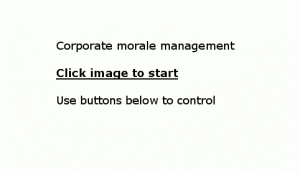
Our unconscious expectations about the world impact significantly what we foreground in our experiences. As we start this ‘DS106 goes to work’ course, Alan Levine reflects on the way work is represented in popular culture,
Comedic or dark and evil – is this the only way corporate culture is represented in popular culture? Might there be other ways to represent it?
In the next few weeks, this shrink wants to focus on precisely this. What are my unchallenged, background assumptions about work? What stories do I tell myself and others about the workplace? One of the most powerful books I have read on the meaning of work is from a sociologist,
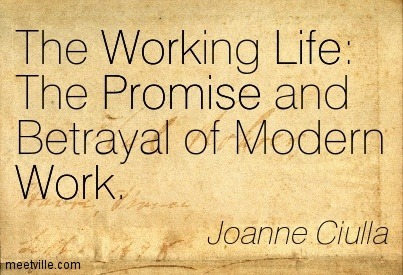
This book is no Hollywood, it is awesome and a difficult read. It challenged many of my pollyanna attitudes about my role as a developer of people and organisations when I first read it a few years ago. Today I look forward to having my attitudes challenged in a more DS106 kind of way: might there be other ways to represent working life beyond stereotypes?
I look forward to everyone’s explorations in the next few weeks. Now, let’s get to work!

It has been a roller coaster. I will be unpacking the experience for many moons to come. Serendipity, or the magic of DS106, at play again as I notice this is post 106 of the blog post I started in August 2013 getting ready for the launch of DS106 Headless.

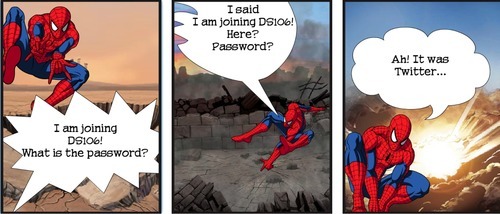
I completed and got my badge, Thank you Jaap Bosman for the lovely boring design. The end.
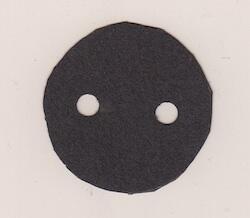
The Headless Shrink Completion Badge

As this run of DS106 comes to an end, I am starting to reflect on what the experience has meant to me. I set out on this journey to forget about the fact that I am an educator and immerse myself in the DS106 experience. I wanted to learn digital storytelling and I was taking a course not teaching it, I kept telling myself throughout.
One of the things that keeps coming up for me as I reflect on my learning is what might have been. I tried to write this post from a theoretical perspective, deconstructing participation, looking at different types of learners online and what is the difference that makes the difference. I could have done that, I may still do that. There are others doing that who know much more about this done I do. I decided instead to write a post about the people I missed during the experience. I missed them, because I would have wanted to learn more with them and from them.
Circumstances were such that I did not get to know them very well and I am sorry about that. Some are active on Twitter and I have light connections with them, some are not and I have none. Here, I wanted to say thank you to them all, for what I have actually learnt from whatever their level of participation. I am sorry that I did not manage to work out a way to connect with you all more. Here are some of the pots of gold I got from you all before you left.
I have a lovely flickr slideshow thanks to Martin Lugton and I was looking forward to doing DS106 Headless 13 with him. This is his DS106 blog. It ends with 3 posts and the intention to take the course.
I met Brian Bennet here and he gave me a preview of a boring video whilst learning time lapse apps. Not watching paint dry, just painting. I put his blog on my Netvibes dashboard of fellow participants and looked forward to learning with him as he stated his intention to do the course with us. 3 posts into Headless he wrote ‘life (literally) has come into my life, and I haven’t been able to carry the momentum.’ After a lovely shark moment in post number 4, no more DS106 tagged posts in his blog. He is an old hand in DS106 and has done the summer version of the course before. I have enjoyed his tweets and some Daily Create moments.
Then I met Ord’s Board with this post. I realised she had been trying to do DS106 and looked through her blog. I found her first post with great enthusiasm for the course. I found this in her second post:
So much to ask of someone to complete before midnight—someone who has spent the previous 48 hours sifting through 100′s of webpages on University of Mary Washington’s ds106 website.
She was about to complete her first Daily Create after spending a long time finding out what to do to get going with DS106. She did it.
I knew she was a she because she posted a lovely sketch ‘for her friends in DS106’. I posted a few tweets saying go give her some comment love, she is new. Today I checked her Twitter feed:
Trying to get my Twitter feed to display on my WordPress site. Lots of in the trenches learning going on here … #ds106
— ord (@ordsboard)
Her only Tweet. Christina responded and offered help. There were no more tweets from Ord’s Board. Her last post dated November 17, 2013. She has been following the daily creates, has not managed to get Twitter to work, I have not seen her on Google Plus.
Then there was Beijing Dog. Philip I found out on Twitter. I discovered his blog with this post. Blog set up for Headless, he gave me a highlight of the whole course: A cat with an identity crisis.

He says on week 2 that he is not quite managed to get into Twitter,
The twitter connection is not working yet. Got to tweak with it a bit more, or ask for help on twitter. So far I am satisfied with the feel of the blog. Now I will have to keep on tweaking.
He has 68 tweets. Last one on DS106 61 days ago. He expressed intention to be involved in the Radio Shows but it was not to be. His last Ds106 post on October 6th. He was working along the weekly assignments ‘with me’ I was enjoying his photos, his humour, his reflections. I missed him when his path took him elsewhere.
Then there were 2 people I knew from H817 and who started with me. Gitte Bailey Hass interacted with us mainly on Google Plus. I did a search in the community for ‘Gitte, here are your best bits!’ and this was the result.
Her Headless animated Gif, I loved for its clean lines and simplicity. Her technical skill would have been welcomed during the hard months trying to get stuff to move and fade in different editors for no reason at all except the joie of art, Bub! In her last post dated September 27th she defines herself as a lurker:
The offline life keeps me more busy than expected, so I have to face, that I´m not participating here in the level, that I want to do. But I do lurk on you guys and I´m impressed of your work.
She helped us in any way she could on Google plus, I wonder how much more I would have got from the course had she been able to participate more.

Then there was @littlemissmooc I was excited that she has chosen to join us for the Headless journey. She was new to Twitter but she decided to try,
@mdvfunes Have been following #DS106 and am inspired by everyones’ creativeness. Time to join in I think!
— Catherine Dartnall (@LittleMissMooc)
Her offline life took her elsewhere, 15 tweets later she left. An empty Tumblr Blog, a Daily Create on Soundcloud she was really excited to have completed.
Then there was @shannotate I loved her Digital Storytelling rant, and really looked forward to engaging with her critical reflective mind.
She said that ‘with the start of the headless approaching, I’m gearing up to get involved as much as I can while working full time.’ She asked a question that has resonated for me for months in that same post: ’how much of that art is really ours?’ She is active on Twitter but not on the DS106 stream at the moment. Looking at her blog, it seems she has been around it for more than 2 years. She is just new to me, not to DS106. I loved her tutorials and have them stored in Pocket to do once DS106 Headless ends on Friday. I would have loved for us to be full time on Headless together. I must quote her advice to future students:
To any prospective students of the course possibly reading this post, this is not a class that is easily taken and then forgotten. ds106 sticks with you for many reasons, and teaches you a lot. It taught me to make art, damnitt.
She made a big impact on me at the start of this journey.
I recently found Sally Wilson’s blog. She has done the lot! Yet we have not connected. I loved seeing her blog and finding somebody else who was a ‘proper’ ( in my eyes only 🙂 participant. She even did the Chaplin Clip narration, nobody else did it in this Headless as far as I know. It is meticulous work, I enjoyed it a great deal and I am submitting it as a best of Headless. Yet, I feel I missed Sally along the way. She says ’follow my infrequent posts’ on Twitter. I follow her and they are infrequent. Her last activity was on the radio shows and she chose a different radio team.
The final person I wanted to mention was Martha Burtis, she only commented once on an early post.
Yes – I can identify with the urge not to step out of the creating (and the childlike wonder that comes with it) to reflect. I struggle with it all the time. The creating can be hard and challenging, but the reflecting is hard and challenging in a different way. It’s difficult to explain how “hard” can mean different things in different contexts. It’s like I always describe my relationship with writing. It hurts me to write (I love to write). It hurts like the pain of climbing a very steep trail (I love to hike).
Can’t wait to see all your creations and reflections in #ds106!
I found myself looking forward to engaging with her as a result of this comment as it seemed to speak to a tension I know deeply both personally and professionally. It was not to be. Twitter contact has been light and infrequent, life took her to things other than Headless 13.
These are the people I noticed and missed, the ones I wanted to learn more with but their paths took them elsewhere.
There are also the ones I did not find, the ones I did not like, the ones I did not learn from…Where is the centre online? Where is the centre in a course with no head? Reading the paragraph I just wrote one more time – the reference point is that digital echo chamber that is the ‘I’.
This is how it is for me, may be I am just more self referenced than most. I certainly know that the instinct to be open and share online is something to be cultivated and not something that comes naturally for me.
I have saved the best for another post, what I have learnt from all the wonderful people that have come on this journey with me, the ones that have made this experience unforgettable and who I hope will be #4life.
To those of you I have missed this time around, may our paths meet again more deeply in the future.
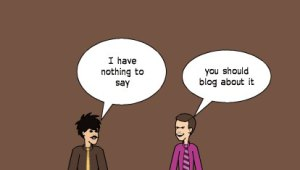
Copyright © 2024 DS106 on the couch
Theme by Anders Noren — Up ↑
Commenting for learning
For week 2 of the GMU #ds106 course being taught this Spring by Alan Levine, one of the headings in the weekly assignments this week was ‘giving and receiving peer feedback’. Whilst this can often be one of those topics that makes us yawn and say ‘yeah! I know that stuff’, it is also something so important that it can make or break an experience online or offline.
I also knew that Alan would not let us down and would find interesting nuggets for us to read on this topic. So, I decided to focus my work this week on this topic in the hope it may serve those new to this process. In my own work using self managed learning to teach a Masters level qualification we major on this topic too. If your grades depend on the quality of feedback and the assessment skills of your peer learning group, the subject is almost as important whatever the content of the course might be.
I find this particularly interesting as I have been reflecting on how to adapt some of the methods I use when I facilitate learning groups offline to support open education online. My plan here is to review what Alan has offered us and add some ideas from my own work. I am starting to form a view that ‘commenting’ generally has overlaps and also differences with ‘commenting for learning’. Here is how the weekly assignment frames the process. It is now time to,
Three aspects are highlighted here:
I am interested in the fact that Alan has made a choice to put the GMU students in learning groups. In usual DS106 style, no boring group names here, the web to the rescue with a Fantasy Team Name generator! The teams are pre-assigned and name is selected. This is interesting to me because in the self managed learning methodology I use, the control of all these parameters rests with the learners. At the first residential the students choose their ‘learning set’ and one of their first tasks is to chose a name for the set. We allow at least half a day for this selection process to be done by the whole group before they meet in their learning sets for the first time the other half day!
Opening the tab of the weekly assignments and seeing the neat and fun named groups made me stop and think. In my case, the students stay together for 18 months – so I could say may be it matters more that they chose for themselves? Yet, I know other institutions that use similar self directed approaches that put their students through the process I described above each term! I am left wondering if in the name of an ideology we make it unnecessarily difficult for our students.
I also note the groups are called ‘comment groups’. So there is a clear task they have to accomplish. Research in online learning does seem to show that a task focus makes it more likely that groups online will succeed. The same research seems to indicate that pairing people up will help them learn more effectively than just learning alone. In one tab, DS106 has pragmatically and efficiently created clear conditions for success. In my ‘learning sets’, the task is not clear even though we do instantiate the idea of learning together is better than learning alone. It is not uncommon for learning set to spend several weeks deciding how they will work, agreeing assessment criteria, and setting up a ‘to do list’ for the set. Admittedly they are working towards a Masters level qualification and part of their learning has to be about the self managed learning process, but once again I am left thinking if we make it unnecessarily complicated because we are kneeling at the altar of our cherished pedagogy.
Online as a medium for learning requires that we re-think how we do things. As I opened that tab and saw the groups, I was left wondering if self-direction in the sense of ‘no direction’ unless the student sets it is in the service of learning or dogma.
The post continues offering clear guidance as to how to make the comment groups work technically – follow others in your group and it will be easier to access what they write.
We then move on the the meat of this post for me. What does it mean to ‘comment well’? There are the usual guidelines to specificity and why this matters particularly to make it easier for fellow students to make choices about what they incorporate into their work having understood the feedback.
If the comment is specific then action can be taken, if it is just an expression of like/dislike the receiver may now know something about the giver’s tastes but does not have quality data to use.
Several ideas about how to comment well are offered and two excellent (and funny) references to read more. Here I am just going to take the bullet points from these posts but I highly recommend you take time to read them.
Some quick and dirty tips from the first post:
I could go on for hours about the first one, but I will not. Let me just say that I have been on the receiving end of very mixed motivations when people have commented on my writing online, and I have gone to people’s blog with mixed motivation to comment myself. It is useful to take the time to address that first bullet before you even start to comment. In the context of this post ‘commenting for learning’ and of this run of DS106 – the motivation is clearly laid out: you comment to learn yourself and to support your colleagues learning. That is all.
In a sense the frame of learning should make commenting easier. The fact that comment groups have been set up should also help, it means you have a more limited load on you to read meaningfully what your colleagues write.
The next post explores key questions you might choose to ask yourself if you want to be a good commenter. Do you want to be a good commenter?
It is a funny post but it makes a very serious point. One of the things I value the most in DS106 is that it teaches us how to be good digital citizens. It teaches us to use the web in a way that maximises its possibilities and that means being explicit about what it means to interact functionally rather than dysfunctionally online. And the reference to this post on the weekly assignment is a great example of this. I say reading it is a must, but here are the 10 key questions to ask yourself before ‘you press that post button’,
John Scalzi may be too in your face for some tastes, but bringing it back to commenting for learning what he says bears reading and re-reading. I am new to blog commenting and never thought my life would take me down this path. In the last year, I have been on the receiving end of wonderful commenting that has taken my DS106 work to another level. I have also, rarely in the DS106 community I have to say, been on the receiving end of posters who did not ask themselves any of these questions before pressing the post button. It is painful and totally avoidable with a little forethought.
John says,
I love this statement. It offers a clear guideline to find balance in feedback and makes it acceptable to offer the type of feedback that may help us change. My best example of this in DS106 was when we were learning about minimalist posters. You can read the detail here it is worth reading as an example of how you can be really helpful to your comment group – I was told that to do it well I had to change what I was doing, offered an example of how to do what I could not, and positive reinforcement once I had another go even when my output was not (shall we say?) terribly smooth.
The weekly assignment also offers guidance on how to respond to comments and suggests that we think of them as a conversation to avoid a sense of one-sideness in those who take the time to comment.
I would add to that that in the context of commenting for learning, the conversation is for a purpose. It is not just small talk or networking.
In my learning groups we organise time with individual air-time for each participant. This air-time is time for each student to use as they see fit given their learning contract. They are in control and manage the conversation. I see this as analogous to using a blog for educational purposes. My blog is the place where I have my air time, and where I manage the conversation to help me achieve my learning goals.
I too (unsurprisingly) have a set of questions I give my students. I add them here, as I end this post, as I think the complement what we have been offered this week by focussing on the learning process and people more than on the written word.
I suggest that as the blog owner you ask yourself these questions as you read your comments, and post ‘feedback on the feedback’:
I say to my students if you get to the end of your time and you have not got what you needed from the group, it is because you did not have the courage to act on the answers to the above questions. If you are not getting what you need, tell us, and tell us what you want instead. It is not that hard if we assume we are all here to help each other learn.
If you are the commenter, ask yourself these questions as you read the post carefully ( i.e. more than a quick scan)
People will give you clues in their posts as to what they need from you as a commenter. Watch the tendency we all have to go off on tangents, and stay focused on commenting for learning. As you get to know your comment group you will start to see patterns in their behaviour and their output. We are not great at noticing patterns – for good or not – and hearing them from those who are helping us learn can help us change.
For example, I have a tendency to devalue what I produce in DS106. I have (had?) a belief that says that I am an academic not an artist. So, I started DS106 calling my output mere artefacts. It has taken me a long time, but you will now (as a result of feedback from the DS106 community which met all the criteria I have spoken about here, of course 🙂 see the tag #gifart in some of my animated gifs. This may seem like a small thing, but it does show a change in habitual patterns that others noticed and flagged up.
In closing, I am glad I took the time to reflect on commenting rather than get involved with what may have seemed a more fun assignment. The more I reflect on this process (which is at the edge of learning online in my view), the more I see that unless we have online spaces that support good quality interaction of this kind and us (as students and teachers) implementing best practice in commenting for learning, the potential of open education will not be realised. But that is another story…
Bibliography
Cunningham, I. (1999). The wisdom of strategic learning: The self managed learning solution. Gower Publishing, Ltd.
Dowes, S. (2010) The role of the Educator
Enyedy, N., & Hoadley, C. M. (2006). From dialogue to monologue and back: Middle spaces in computer-mediated learning. International Journal of Computer-Supported Collaborative Learning, 1(4), 413-439.
Myers, D. (1987a). A new environment for communication play: On-line play. In G.A. Fine (Ed.) Meaningful Play, Playful Meaning (pp. 231-245). Champaign, IL: Human Kinetics Publishers.
Uribe, D., Klein, J. D., & Sullivan, H. (2003). The effect of computer-mediated collaborative learning on solving III-defined problems. Educational Technology Research and Development, 51(1), 5-19.
Xin, C., & Feenberg, A. (2006). Pedagogy in Cyberspace: The Dynamics of Online Discourse. Journal of Distance Education, 21(2).
Witthaus, G. (2014) Should MOOC students be grouped?